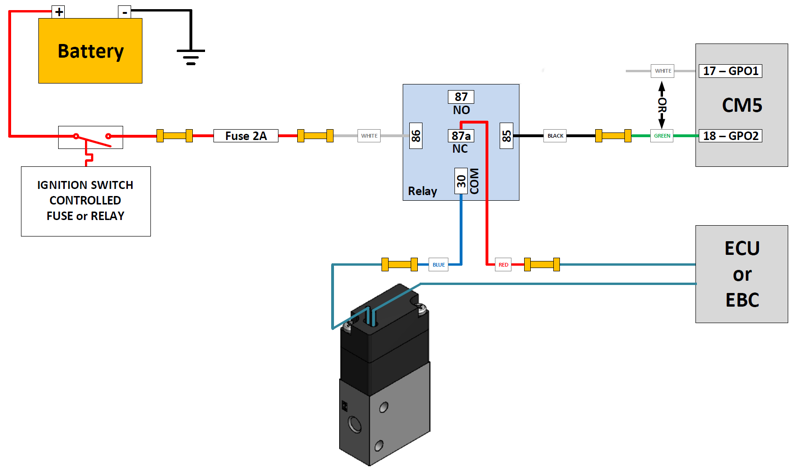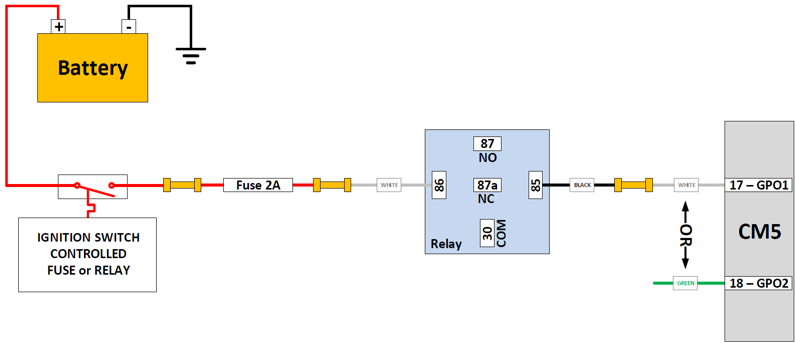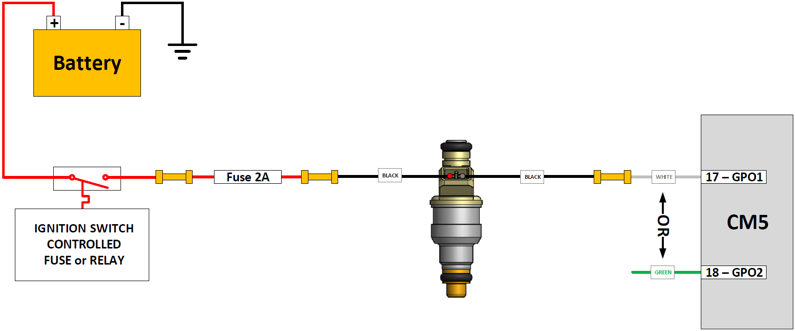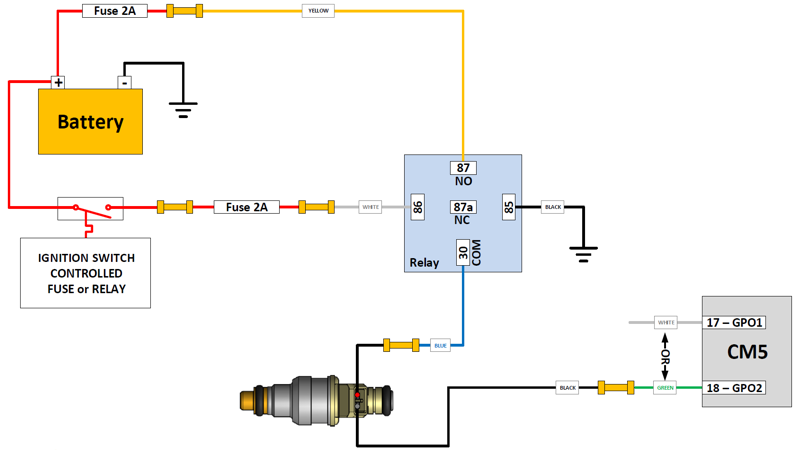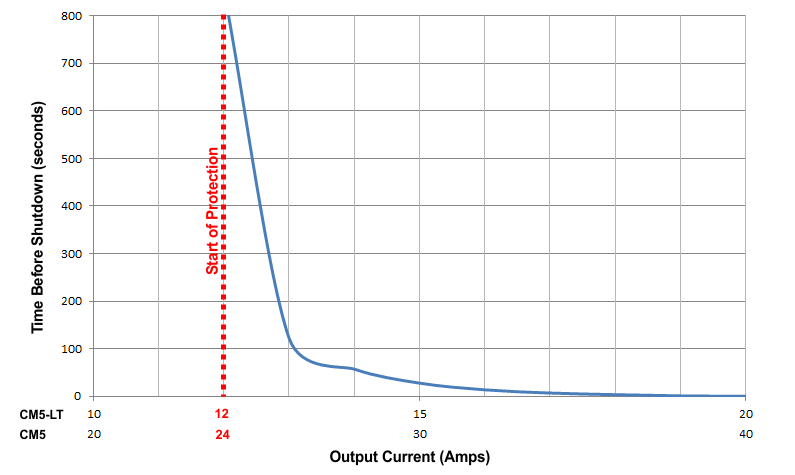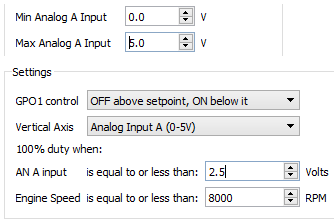Torqbyte units are intended for driving heavy electrical loads. This makes proper power and ground wiring absolutely essential. Poor or inadequate wiring can prevent the unit from operating properly (at best) or could cause a fire hazard. If the installer is not familiar with basic electrical theory, lacks the proper assembly tools, or is not familiar with the target vehicle's electric system, the installation should be referred to an experienced professional.
In this post we will look at several options that can be used to provide proper power and ground wiring for your Torqbyte unit(s).
Before we get into all the details, let's first address some Frequently Asked Questions:
Q. Do I need to install a fuse?
A. Yes, you do.
Q. Why?
A. Fuses protect wires from overheating and possibly catching fire, which could happen if a power wire gets shorted to ground with nothing to limit the huge current that will start to flow. Any time you have a power wire running any significant length away from a power source (i.e. the car's battery), you should install a fuse.
Q. Where should I install the fuse?
A. To be effective the fuse MUST be located as close to the battery as possible. Any length of wire between the battery and the fuse is no protected, so it's important to keep this length as short as possible.
Q. What wire is used in your kits?
A. We only use the SXL automotive wire that meets the SAE J1127 standard. The SXL-10 wire we use is a heavy gauge automotive wire that also has an extra thick outer jacket.

Q. I don't live in the US or Canada. Where can I get this 10AWG (aka 10 Gauge) wire?
A. AWG stands for American Wire Gauge, so the 10AWG wire is generally specific to the North American geographic market. While you may be able to get 10AWG wire in your country, or may be able to order it online and have it shipped to you from a US supplier, we would recommend that you source the functionally equivalent European 6.0mm^2 LEONI Mocar® 125 XE or LEONI Mocar® 180 E automotive wire.
Q. I don't live in the US or Canada. Where can I order these extra bits and pieces?
A. Almost all of the electronic distributors listed above, particularly DigiKey, Mouser and Newark have physical offices and serve customers in many different countries throughout the world. We would recommend sourcing the required material locally to keep your costs down.
Q. Should I crimp or solder?
A. Always crimp. Never solder. Almost every automotive manufacturer prohibits the practice of soldering wires. The primary reason is that soldering can make copper brittle and affect the long-term reliability of the solder joint in a high vibration automotive environment. Crimped joints are mechanical and electrically superior, anyways. Don't solder.
Q. The recommended crimping tools (discussed at the bottom of this post) are quite expensive. I'd like to avoid paying that much money for a one-time use tool. Is there any other way that I can crimp these wire splices and terminals?
A. You are absolutely right that those tools are pretty expensive if you don't think that will use them more then once or twice. As with anything, there is always a different way to do something. Will that other approach produce results that are the same, better or worse than what can be achieved when using the recommended tools and procedures? We don't know. So we can't recommend anything that we haven't tried and that may conflict with the manufacturer's recommendations.
Q. This is all great to know, but I don't have time to read all this and even less time to make my own power wiring. Can you custom-make all the necessary wiring for me and just send me a ready-to-install harness?
A. Absolutely. We have all the materials and manufacturer-recommended tooling in-house and all we need from you is a napkin sketch, a few measurements.
Alright... Let's get started.
We will make a number of references here to Volkswagen and Audi vehicles just to illustrate the relevant topics. However, the concepts described below can be easily extended to a vast majority of modern vehicles.
We will focus our attention on the fuse box in the engine compartment because it is the most convenient location from which to pick up battery power. The reason that fuse box is a good starting place is that it comes with spare wire guides, studs/fasteners and a protective cover which will protect the new wiring and ensure the installation looks clean and neat when everything is put back together. Although this discussion is most applicable to vehicles with a front-mounted battery, the concepts are the same for vehicles with a trunk-mounted battery.
The fuse box in question is shown below:

Power Wiring Front Battery Option A
If you are installing the power wiring on a VAG vehicle that comes with a power distribution module with integrated fuses VW Part No. 1K0 937 829 (A), your job will be relatively simple.
The rightmost 40A fuse on this module is usually not used in the cars that use it. That 40A also happens to be the exact value that we need.

Note: Only use the 40A location !!! Anything with a rating higher than 40A will not protect your 10AWG wiring.
As we can see in the vehicle shown below, the rightmost 40A fuse is not used and the output end of the fuse even has an M5 stud that can receive our power wire.

The first thing you'll need to get is a yellow (10AWG) ring terminal (or ring lug) with a hole that can accept an M5 stud.

Although you can use whatever ring terminal you want we recommend either a TE Part No. B-106-1503 which is a heat-shrinkable and sealed ring terminal from their Dura-Seal product line or TE Part No. 130171 which is an unsealed terminal from their PIDG product line.
The Dura-Seal ring terminal can be purchased from E-Sonic.
The PIDG ring terminal can be purchased from DigiKey or Newark.
It should be noted that the other ring terminals in the fuse box are not sealed so it's up to you if you want to keep everything unsealed like the OEM or opt for a sealed terminal.
Using the recommended crimping tool (discussed at the bottom of this post), crimp the ring lug onto the 10AWG wire that you have previously run from the unit's location out to the fuse box. If you are using sealing ring lug, don't forget to heat shrink the insulation until the internal adhesive flows to form a seal around the wire (more on this at the bottom of this post).
The next thing that's required is an M5 nut. You can use a VW Part No. N 101 181 02 which is a self-locking, shouldered M5 hex nut used on other fuses in the fuse box, or you can use a regular stainless steel M5 hex nut and an M5 split lock-washer (Don't forget the lock-washer).
Your final configuration should something like this:

Power Wiring Front Battery Option B
If that rightmost integrated 40A fuse is unavailable,

or your fuse box doesn't even come with an integrated fuse module

but there is an unused M5 stud available, then you can still achieve the same result described in Option A, except that you will need to provide your own 40A fuse and some hardware to keep everything in place.
The first thing you'll need to get is that 40A fuse.
You can order this fuse from your local VW/Audi dealer under VAG Part No. N 10525501 or you can order it from one of the online electronics distributors using the manufacturer's Part No. 153.5631.5401. This LittelFuse part is available from DigiKey or Mouser.
As with Option A, you will need an M5 nut to secure the fuse to the M5 stud in the fuse box. You can order a VW Part No. N 101 181 02 which is a self-locking, shouldered M5 hex nut used on other fuses in the fuse box, or you can just use a regular stainless steel M5 hex nut and a stainless M5 split lock-washer. (Don't forget the lock-washer unless you are using the VW hex nut).
Again you will need an M5 ring terminal and, as before, we recommend using a TE Part No. B-106-1503 which is a heat-shrinkable and sealed ring terminal from their Dura-Seal product line or a TE Part No. 130171 which is an unsealed terminal from their PIDG product line.
The recommended Dura-Seal ring terminal can be purchased from E-Sonic.
The recommended PIDG ring terminal can be purchased from DigiKey or Newark.
It should be mentioned that other ring terminals in the fuse box are not sealed so it's up to you if you want to keep everything unsealed like OEM or use a sealed terminal.
Using the recommended crimping tool (discussed at the bottom of this post), crimp the ring lug onto the 10AWG wire that you have previously run from the unit's location out to the fuse box. If you are using sealing ring lug, don't forget to heat shrink the insulation until the internal adhesive flows to form a seal around the wire (more on this at the bottom of this post).
Finally, you'll need a nut and bolt to connect your ring lug to the other side of the fuse. You can order a shouldered M5x13.5mm bolt VW Part No. 1K0 919 625 and a second self-locking, shouldered M5 hex nut VW Part No. N 101 181 02 or you can just buy a stainless M5 Hex Bolt (about 14mm long), a matching M5 split locking washer and a matching M5 hex nut.
Your final configuration should something like this:

When everything is in place, your final set-up should look something like this:

Power Wiring Front Battery Option C
If the vehicle you are working on does not have a fuse box similar to the one described above, the last remaining option is to connect the power wire directly to the battery's +ve terminal. This is the traditional approach used when installing new electrical equipment in a vehicle and, if done properly, it will still produce a very clean and reliable end result.
To start you will need a covered automotive inline fuse holder and a corresponding 40A automotive fuse.
We recommend using a LittelFuse fuse holder Part No. FHJC1001G, which is shown below.

This fuse holder can be purchased from DigiKey or Mouser.
The corresponding 40A fuse that fits inside this fuse holder is LittelFuse Part No. 0895040, which is shown below.

This 40A fuse can be purchased from DigiKey or Mouser.
While one of the free-hanging wires on the fuse holder will be connected to the battery with a ring terminal, the other wire will need to be joined to the positive wire that goes out to the unit. To join the fuse holder's "output" wire to your poitive wire run going to the unit, you will also need a yellow (10AWG) sealed wire splice. You can buy a yellow 10AWG splice from your local VW/Audi dealer under VAG Part No. 000 979 943 , but you will have to confirm with them what crimping tool you should be using, because we don't know who makes the splice VW sells nor what is their recommended crimping tool. On the other hand, you can get a slightly better quality yellow 10AWG wire splice from your local General Motors dealer under GM Part No. 19168448, which can be used with the same ratcheting crimping tool as the Dura-Seal splices and contacts described at the bottom of this post. If you'd rather not buy parts from a dealer, we recommend using a TE Part No. D-406-0003, which is a heat-shrinkable and sealed wire splice from TE's Dura-Seal product line.

This Dura-Seal wire splice can be purchased from DigiKey or Mouser.
The last item that you will need is a ring terminal with an opening that can accommodate the diameter of the bolt on your battery's positive terminal.
As with the other two options, we recommend either a sealed ring terminal from TE's Dura-Seal product line or an unsealed terminal from their PIDG product line.
All the 10AWG-compatible ring terminals from TE's sealed Dura-Seal product line are shown below:

All the 10AWG-compatible ring terminals from TE's unsealed PIDG product line are shown below:

Once you have selected a ring terminal part number from the above tables that works with the hardware on your battery's +ve terminal, one of the quickest ways to check where you can buy it, is to enter its part number in the Octopart Search Engine which will show you the current stock of that part at nearly every electronics distributor.
Your final configuration should look something like this:

You should cover the new power wire with some sort of a protective polyester braid or wire loom. Obviously you should not run this wire near any sources of high heat nor any moving parts that may wear through the insulation over time. Also, any time a wire is passed through a piece of metal (like your firewall) it should go through a grommet or a cord grip protect the wire's insulation from getting cut by the sharp edges of the opening that it's passing through.
Power Wiring Rear Battery
If the vehicle you are working on has a trunk-mounted battery, such as a 2011 Audi A4, the +ve battery terminal assembly attachment may already have a location for a spare fuse that you can use.

The first thing you'll need to get is that 40A fuse.

You can order this fuse from your local VW/Audi dealer under VAG Part No. N 10424902 or you can order it from one of the online electronics distributors using the fuse manufacturer's Part No. 156.5677.5401. This LittelFuse part is available from Mouser.
You will need an M6 ring terminal and, as before, we recommend using a TE Part No. B-106-1603 which is a heat-shrinkable and sealed ring terminal from their Dura-Seal product line or a TE Part No. 320569 which is an unsealed terminal from their PIDG product line.
The recommended Dura-Seal ring terminal can be purchased from E-Sonic.
The recommended PIDG ring terminal can be purchased from DigiKey or Newark.
Finally, you'll need two M6 nuts to bolt down the fuse and the ring terminal to the two M6 studs on the battery's +ve terminal block. You can order a flanged self-locking M6 hex nut VW Part No. N 904 880 05.

Alternately you can just buy a stainless steel M6 Hex nut and a matching M6 split locking washer (don't forget the split locking washer if you are using regular "hardware store" M6 nuts).
Your final configuration should something like this:

Ground Wiring
At this point, you should have a pretty good idea about the best way to bring fused power to your Torqbyte unit. The next thing we will focus on is grounding.
The ground connection should not be routed all the way to the battery's -ve terminal, unless the unit is physically very close to the battery, as it might be in the case of a trunk-mounted PM3 in a vehicle (like and Audi A3) that has a trunk-mounted battery.
The ground connection should be as short as possible and just like the +ve power connection the ground connection should be made using 10AWG wire. Obviously do your best to color code the wires based on their function. Use RED wire for power and BLACK wire for ground. This is a good practice and will make your (or someone else's) life easire of you ever have to troubleshoot this wiring in the future.
A technical service wiring diagram for most vehicles shows the factory grounding points throughout the vehicle. You should try to use one of those grounding points unless they are not very accessible or unless you are very confident that you have found another ground connection point that is going to work (i.e. it makes a good electrical contact with the car's chassis).
Here are some examples of potential chassis grounding points in a couple of VAG vehicles.
In a 2012 VW Golf GTI, one of these two points can be used. There are other suitable grounding points that are not shown here.

In a 2012 Audi A3, one of these points can be used. As before, there are other suitable grounding points that are not shown here.

In a 2011 Audi A4, any one of these three grounding points in the spare wheel well can be used for grounding.

Once a grounding point is selected, it's important to measure the diameter of the protruding stud or the grounding bolt and select a proper ring terminal from one of the two tables shown above. Typically Volkswagen uses M8 studs for grounding points in which case you should use.
Although you can use whatever ring terminal you want, we recommend either a TE Part No. B-106-1803 which is a heat-shrinkable and sealed ring terminal from their Dura-Seal product line or TE Part No. 2-35111-1 which is an unsealed terminal from their PIDG product line.
The Dura-Seal ring terminal can be purchased from E-Sonic.
The PIDG ring terminal can be purchased from DigiKey or Newark
With the right ring terminal on hand, the next thing that is required is to prep the mounting location to receive your ground wire ring terminal. While some of these grounding points will be clean, paint -free and otherwise good-to-go, you may select a grounding location which may be oily, dirty or might be painted. Since both the PM3 and the CM5/CM5-LT return a lot of current into the chassis ground, a very good electrical connection is a MUST. Shown below are a few notes on how to prep a painted stud located in the trunk of a 2012 VW Golf GTI.

If the chosen grounding location requires extra hardware (a nut and a split locking washer) you will need to get those as well in order to complete your installation. Once all the pieces are on hand, your final configuration should look like this:

Crimping Tools and Assembly Notes
PIDG Product Line (Unsealed)
The recommended ratcheting hand crimper for PIDG wire terminals is the TE Pro-Crimper III Part No. 58433-3.

Pro-Crimper III for PIDG terminals can be purchased from DigiKey.
Wires that will be crimped into a PIDG ring terminal need to have a strip length of 8.3cm (0.328").
Some manufacturer's notes on the assembly of PIDG terminals are shown below.

Dura-Seal Product Line (Sealed)
The recommended ratcheting crimper for Dura-Seal wire splices and Dura-Seal ring terminals is TE Part No. AD-1522. It's worth mentioning that the General Motors Tool No. J-38125-8 (or GM Part No. 12085115) is interchangeable with AD-1522.

AD-1522 for Dura-Seal terminals can be purchased from Mouser.
Wires that will be crimped into a Dura-Seal wire splice need to to have a strip length of 8.5mm (0.335").
Wires that will be crimped into a Dura-Seal terminal need to have a strip length of 7.0mm (0.275").
Some manufacturer's notes on the assembly of Dura-Seal splices and terminals are shown below.




























